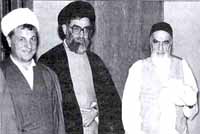NCRI Peace Initiatives
To end the war's misery and destruction, and to stop the regime from using the conflict as an excuse for domestic repression and inability to meet the public's needs, the National Council of Resistance "launched an extensive campaign for peace inside and outside of Iran."1 The fighting could be concluded, Mr. Rajavi said, only by "direct negotiation between the two sides within the framework of the sovereignty and the territorial integrity of the two countries.2
The NCRI's first major initiative was the Peace Plan, announced on March 13, 1983. It called for an "immediate declaration of a ceasefire between all forces," the "withdrawal of forces of both countries behind the frontiers...[based on the] territorial boundaries between Iran and Iraq," and an "exchange of all prisoners of war within a maximum period of three months after the declaration of the ceasefire." Additionally, the international boundary would return to the demarcation specified in the 1975 Algiers Agreement (the boundary prior to the war). And damages from the conflict would be arbitrated by the International Court of Justice and its findings would be binding.
The Peace Plan also called for the "drawing up of a definite peace treaty between the two countries, on the basis of full respect for national sovereignty and independence, territorial integrity, non-intervention in each other's internal affairs, good neighborliness and immunity of boundaries to aggression."
The Peace Plan contained the key issues demanded by the mullahs in May 1981 to stop the conflict; a ceasefire and simultaneous withdrawal of Iraqi forces from occupied Iranian territory, which already had occurred, the restoration of the border with Iraq as defined by the 1975 Algiers Agreement, and an investigation to determine blame in starting the war.3
Response
Iran's mullahs announced their response to the proposed Peace Plan at a press conference in Tehran. Iranian President Khamenei "vehemently" rejected the initiative, claiming it was a ruse by Iraq to buy time to rearm and again strike against Iran.4
Peace Plan at a press conference in Tehran. Iranian President Khamenei "vehemently" rejected the initiative, claiming it was a ruse by Iraq to buy time to rearm and again strike against Iran.4
In truth, the mullahs wanted to continue the war in order to consolidate their power at home. The conflict allowed them to impose severe measures to block potential opposition. The mullahs also were determined to overthrow Saddam and install a fundamentalist Islamic republic. Three months earlier, Khamenei had endorsed he formation of the Supreme Council of the Islamic Revolution in Iraq, a government in exile. It was set up to create a "grassroots movement against the usurping regime of Iraq, to mobilize the people against it, to continue their struggle until the downfall of the present usurping regime and until the establishment of a popular and Islamic order."5
While Khamenei dismissed the Peace Plan, the initiative was endorsed by Iraq in a formal statement on March 21, 1983. "We hail the peace initiative expressed in the Council's statement," it said, "and would like to express Iraq's desire to realize peace and to cooperate with the Council or any Iranian to that end, and to establish relations on firm grounds." Iraq said it was "ready to look into these points and has the true and honest desire to reach a just agreement with the National Council or any competent Iranian authority yearning for peace."6
Many parliamentary members and government leaders also endorsed the NCRI's peace initiative. In a resolution, the European Parliament expressed:
"support for the movement for peace and freedom spearheaded by the National Council of Resistance of Iran and the People's Mojahedin Organization of Iran and for its peace plan involving a cessation of all military hostilities by both Iran and Iraq...."7
The resolution condemned "the continuing violation of human rights by the Khomeini regime" and expressed "revulsion at the torture and execution of political opponents, especially those who have participated in demonstrations in favour of peace and freedom."8
The Peace Plan received the backing of the Parliamentary Assembly of the Council of Europe (Resolution No. 849) as well as numerous political parties, organizations, and personalities.
1) "Enemies of the Ayatollahs." Mohammad Mohaddessin. Zed Books, London, New York. 2004.
2) "Iraqi Visits Iranian Leftist in Paris." New York Times. January 10, 1983.
3) "Non-Aligned Peace Commission Takes Message to Iraq." Associated Press. May 11, 1981.
4) "Iran Rejects Peace Plan." United Press International. March 10, 1983.
5) "Iranian President on the War and Political Power Structure." BBC Summary of World Broadcasts. November 27, 1982.
6) "Iraqi Official Welcomes Iranian Resistance Peace Initiative." Baghdad Observer. March 31, 1983. See "Enemies of the Ayatollahs." Mohammad Mohaddessin. Zed Books, London, New York. 2004.
7) "Written Declaration of Peace and Human Rights in Iran." Resolution No. 849. European Parliament. July 8, 1985.
8) Ibid.

